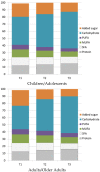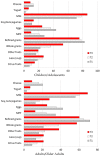Breakfast in the United States: Food and Nutrient Intakes in Relation to Diet Quality in National Health and Examination Survey 2011⁻2014. A Study from the International Breakfast Research Initiative
- PMID: 30200424
- PMCID: PMC6163505
- DOI: 10.3390/nu10091200
Breakfast in the United States: Food and Nutrient Intakes in Relation to Diet Quality in National Health and Examination Survey 2011⁻2014. A Study from the International Breakfast Research Initiative
Abstract
The contribution of breakfast to diet quality (DQ) can inform future dietary guidelines. This study examined breakfast nutrition in relation to overall DQ, using dietary data from the first reported day of the National Health and Examination Survey (NHANES) 2011⁻2014 (n = 14,488). Relative DQ was assessed using the Nutrient Rich Foods Index (NRF9.3) and the USDA Healthy Eating Index 2015 (HEI 2015). The sample was stratified by NRF9.3 tertiles and by age and socioeconomic groups. Four out of 5 NHANES participants had breakfast on the day of the interview. Breakfast provided 19⁻22% of dietary energy depending on age. Breakfast intakes of complex carbohydrates and total sugars were proportionately higher and intakes of protein and fats were lower relative to breakfast energy intakes. Breakfast provided more that 20% of daily intakes of B vitamins, vitamins A and D, folate, calcium, iron, potassium and magnesium. Eating breakfast was associated with higher NRF9.3 DQ scores. Breakfasts associated with the top tertile of NRF9.3 scores had less added sugars and fats than those associated with the bottom tertile. Such breakfasts had more fruit and juices, more whole grain products, more milk and yogurt and less meat and eggs. Breakfast patterns and food choices that favored fruit, whole grains and dairy were associated with healthiest diets.
Keywords: NRF9.3 index; USDA HEI 2015 index; breakfast; dietary intake; dietary quality; nutrition.
Conflict of interest statement
Authors have received funding from General Mills Inc. for analyses of publicly available NHANES datasets and for their contribution to the project. Adam Drewnowski has received grants, contracts, honoraria and consulting fees from numerous food and beverage companies and other commercial and nonprofit entities with interests in diet quality and health.
Figures






Similar articles
-
Breakfast Consumption in Spain: Patterns, Nutrient Intake and Quality. Findings from the ANIBES Study, a Study from the International Breakfast Research Initiative.Nutrients. 2018 Sep 18;10(9):1324. doi: 10.3390/nu10091324. Nutrients. 2018. PMID: 30231551 Free PMC article.
-
Designing Optimal Breakfast for the United States Using Linear Programming and the NHANES 2011-2014 Database: A Study from the International Breakfast Research Initiative (IBRI).Nutrients. 2019 Jun 19;11(6):1374. doi: 10.3390/nu11061374. Nutrients. 2019. PMID: 31248096 Free PMC article.
-
Breakfast Consumption in French Children, Adolescents, and Adults: A Nationally Representative Cross-Sectional Survey Examined in the Context of the International Breakfast Research Initiative.Nutrients. 2018 Aug 9;10(8):1056. doi: 10.3390/nu10081056. Nutrients. 2018. PMID: 30096946 Free PMC article.
-
Breakfast Characteristics and Their Association with Energy, Macronutrients, and Food Intake in Children and Adolescents: A Systematic Review and Meta-Analysis.Nutrients. 2020 Aug 15;12(8):2460. doi: 10.3390/nu12082460. Nutrients. 2020. PMID: 32824257 Free PMC article.
-
The role of meat in the European diet: current state of knowledge on dietary recommendations, intakes and contribution to energy and nutrient intakes and status.Nutr Res Rev. 2020 Dec;33(2):181-189. doi: 10.1017/S0954422419000295. Epub 2020 Jan 10. Nutr Res Rev. 2020. PMID: 31918784 Review.
Cited by
-
Relative validity of the online Meal-based Diet History Questionnaire for evaluating the overall diet quality and quality of each meal type in Japanese adults.Br J Nutr. 2023 Aug 28;130(4):679-693. doi: 10.1017/S000711452200352X. Epub 2022 Nov 3. Br J Nutr. 2023. PMID: 36326086 Free PMC article.
-
Reproducibility and Relative Validity of the Healthy Eating Index-2015 and Nutrient-Rich Food Index 9.3 Estimated by Comprehensive and Brief Diet History Questionnaires in Japanese Adults.Nutrients. 2019 Oct 21;11(10):2540. doi: 10.3390/nu11102540. Nutrients. 2019. PMID: 31640242 Free PMC article.
-
How Important are Cereals and Cereal Products in the Average Polish Diet?Nutrients. 2019 Mar 21;11(3):679. doi: 10.3390/nu11030679. Nutrients. 2019. PMID: 30901972 Free PMC article.
-
Changes in Sport Nutrition Knowledge, Attitudes/Beliefs and Behaviors Following a Two-Year Sport Nutrition Education and Life-Skills Intervention among High School Soccer Players.Nutrients. 2018 Nov 2;10(11):1636. doi: 10.3390/nu10111636. Nutrients. 2018. PMID: 30400200 Free PMC article.
-
Nutritional Recommendations for the Young Athlete.J Pediatr Soc North Am. 2024 Feb 12;5(1):599. doi: 10.55275/JPOSNA-2023-599. eCollection 2023 Feb. J Pediatr Soc North Am. 2024. PMID: 40433081 Free PMC article. Review.
References
-
- Kant A.K., Andon M.B., Angelopoulos T.J., Rippe J.M. Association of breakfast energy density with diet quality and body mass index in american adults: National health and nutrition examination surveys, 1999–2004. Am. J. Clin. Nutr. 2008;88:1396–1404. - PubMed
-
- O’Neil C.E., Nicklas T.A., Fulgoni V.L., III Nutrient intake, diet quality, and weight/adiposity parameters in breakfast patterns compared with no breakfast in adults: National health and nutrition examination survey 2001–2008. J. Acad. Nutr. Diet. 2014;114:S27–S43. doi: 10.1016/j.jand.2014.08.021. - DOI - PubMed
MeSH terms
Grants and funding
LinkOut - more resources
Full Text Sources
Other Literature Sources

